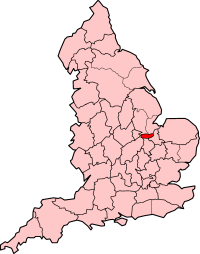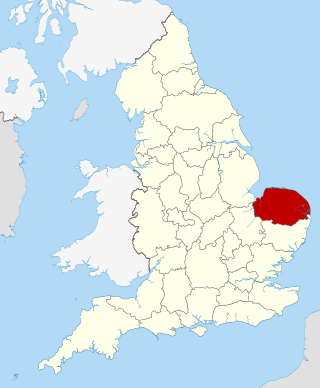
Cambridgeshire is a ceremonial county in the East of England and East Anglia. It is bordered by Lincolnshire to the north, Norfolk to the north-east, Suffolk to the east, Essex and Hertfordshire to the south, and Bedfordshire and Northamptonshire to the west. The largest settlement is the city of Peterborough, and the city of Cambridge is the county town.

The counties of England are divisions of England. There are currently 48 ceremonial counties, which have their origin in the historic counties of England established in the Middle Ages. The current ceremonial counties are the result of the Lieutenancies Act 1997 and are based on the Local Government Act 1972 administrative counties which included a number of new counties such as Greater Manchester and Tyne and Wear. However, some counties introduced by the Local Government Act 1972, including Avon, Cleveland and Humberside no longer exist. The term "county", relating to any of its meanings, is used as the geographical basis for a number of institutions such as police and fire services, sports clubs and other non-government organisations.

The City of Peterborough, commonly known as Peterborough, is a unitary authority district with city status in the ceremonial county of Cambridgeshire, England. The area is named after its largest settlement, Peterborough but also covers a wider area of outlying villages and hamlets.

The Soke of Peterborough is a historic area of England associated with the City and Diocese of Peterborough, but considered part of Northamptonshire. The Soke was also described as the Liberty of Peterborough, or Nassaburgh hundred, and comprised, besides Peterborough, about thirty parishes.

Huntingdon and Peterborough was a short-lived administrative and geographical county in East Anglia in the United Kingdom. It existed from 1965 to 1974, when it became part of Cambridgeshire.

Cambridgeshire and Isle of Ely was, from 1965 to 1974, an administrative and geographical county in East Anglia in the United Kingdom. In 1974 it became part of an enlarged Cambridgeshire.

Cambridgeshire Constabulary is the local territorial police force that covers the county of Cambridgeshire and Peterborough unitary authority. It provides law enforcement and security for an area of 1,311 square miles (3,400 km2) and population of 856,000 people, in a predominantly rural county. The force of Cambridgeshire includes the cities of Cambridge, Ely and Peterborough, the market towns of Chatteris, Huntingdon, March, Ramsey, St Ives, St Neots, Whittlesey, and town and Port of Wisbech. Its emblem is a crowned Brunswick star containing the heraldic badge of Cambridgeshire County Council.

Stanground is a residential area of Peterborough, in the ceremonial county of Cambridgeshire, England. For electoral purposes, it comprises the Stanground South and Fletton & Stanground wards in the North West Cambridgeshire constituency.

Norfolk Constabulary is the territorial police force responsible for policing Norfolk in East Anglia, England. The force serves a population of 908,000 in a mostly rural area of 2,079 square miles (5,380 km2), including 90 miles (140 km) of coastline and 16 rivers, including the Broads National Park. Headquartered in Wymondham, Norfolk is responsible for the City of Norwich, along with King's Lynn, Great Yarmouth and Thetford. As of March 2023, the force has a strength of 1,897 police officers, 163 special constables, 1,318 police staff/designated officers, and 103 police support volunteers. The chief constable is currently Paul Sanford, and the police and crime commissioner is Giles Orpen-Smellie (Conservative).

The Hampshire and Isle of Wight Constabulary is the territorial police force responsible for policing the counties of Hampshire and the Isle of Wight in South East England.

Peterborough City Council is the local authority for Peterborough in the East of England. It is a unitary authority, having the powers of a non-metropolitan county and district council combined. The City was incorporated as a municipal borough in 1874; from 1888, it fell within the jurisdiction of the Soke of Peterborough county council and from 1965, Huntingdon and Peterborough county council. In 1974, it was replaced by a wholly new non-metropolitan district, broadly corresponding to the Soke, in the new enlarged Cambridgeshire. In 1998, Peterborough became independent of Cambridgeshire as a unitary authority, but the city continues to form part of that county for ceremonial purposes as defined by the Lieutenancies Act 1997.
The Local Government Commission for England was established by the Local Government Act 1958 to review the organisation of local government, and make "such proposals as are hereinafter authorised for effecting changes appearing to the Commissions desirable in the interests of effective and convenient local government". Most of the commission's proposals failed to reach consensus and were not implemented, and the body was dissolved in 1967.

The Police Act 1964 (c.48) was an act of the Parliament of the United Kingdom that updated the legislation governing police forces in England and Wales, constituted new police authorities, gave the Home Secretary new powers to supervise local constabularies, and allowed for the amalgamation of existing forces into more efficient units.

The Police Act 1946 was an Act of Parliament of the Parliament of the United Kingdom that provided for the amalgamation of smaller borough police forces with county constabularies in England and Wales, allowed for the merger of county forces in certain circumstances and changed the boundaries of the Metropolitan Police District.
Cornwall County Constabulary was the Home Office police force for the county of Cornwall, England, until 1967.
Cambridge City Police was the territorial police force responsible for law enforcement in Cambridge, England, from 1836 to 1965. From its creation until April 1951 it was known as Cambridge Borough Police. It subsequently merged with four other police forces to become what is known today as Cambridgeshire Constabulary.
Peterborough Combined Police was the territorial police force responsible for law enforcement in Peterborough, England, from 1947 to 1965. It was created from the amalgamation of the Liberty of Peterborough Constabulary and the Peterborough City Police.
The Liberty of Peterborough Constabulary was the territorial police force responsible for law enforcement surrounding 'The Soke of Peterborough', England, from 1856 to 1947. It was initially controlled by the Chief Constable of Northamptonshire Captain Henry Lambert Bayly 1857 - 1876. The constabulary had its headquarters in the old gaol behind the Sessions House on Thorpe Road in Peterborough.
The ceremonial county of Cambridgeshire, which includes the unitary authority of Peterborough, has returned 7 MPs to the UK Parliament since 1997.
















